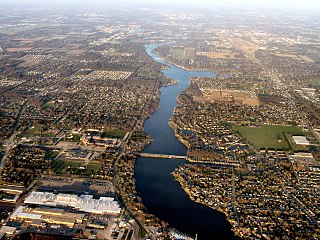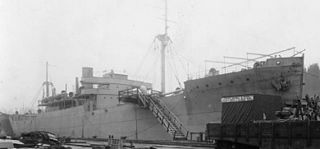Related Research Articles

Elkhart County is a county located in the U.S. state of Indiana. As of 2020, the county's population was 207,047. The county seat is Goshen. Elkhart County is part of the Elkhart-Goshen Metropolitan Statistical Area, which in turn is part of the South Bend-Elkhart-Mishawaka Combined Statistical Area. It is also considered part of the broader region of Northern Indiana known as Michiana, and is 20 miles (32 km) east of South Bend, Indiana, 110 miles (180 km) east of Chicago, Illinois, and 150 miles (240 km) north of Indianapolis, Indiana. The area is referred to by locals as the recreation vehicle (RV) capital of the world and is known for its sizable Amish and Old Order Mennonite population.

Elkhart is a city in Elkhart County, Indiana, United States. The city is located 15 miles (24 km) east of South Bend, Indiana. Elkhart has the larger population of the two principal cities of the Elkhart-Goshen Metropolitan Statistical Area, which in turn is part of the South Bend-Elkhart-Mishawaka Combined Statistical Area, in a region commonly known as Michiana. The population was 53,923 at the 2020 census. Despite the shared name and being the most populous city in the county, it is not the county seat of Elkhart County; that position is held by the city of Goshen, located about 10 miles (16 km) southeast of Elkhart.

Mishawaka is a city on the St. Joseph River, in Penn Township, St. Joseph County, in the U.S. state of Indiana. The population was 51,063 as of the 2020 census. Its nickname is "the Princess City". Mishawaka is a principal city of the South Bend-Mishawaka, Indiana — Michigan, Metropolitan Statistical Area.

South Bend is a city in and the county seat of St. Joseph County, Indiana, United States, on the St. Joseph River near its southernmost bend, from which it derives its name. At the 2020 census, the city had a total of 103,453 residents and is the fourth-largest city in Indiana. Located just south of the border with Michigan, South Bend anchors the Michiana region and is 72 miles (116 km) east of downtown Chicago. The metropolitan area had a population of 324,501 in 2020, while its combined statistical area had 812,199.

The St. Joseph River is a 210-mile-long (340 km) river that flows in a generally westerly direction through southern Michigan and northern Indiana, United States, before emptying into Lake Michigan. The St. Joseph River drainage basin covers 4,685 square miles (12,130 km2), and is the third largest watershed draining to Lake Michigan. The land within its bounds is primarily used for agriculture. The river and its tributaries provide a variety of paddling and fishing environments. Historically, the river served as an important canoe transportation route for various Native American tribes, and for French Canadian Voyageurs.

Donald C. Cook Nuclear Plant is a nuclear power plant located just north of the city of Bridgman, Michigan which is part of Berrien County, on a 650-acre (260 ha) site 11 miles south of St. Joseph, Michigan, United States. The plant is owned by American Electric Power (AEP) and operated by Indiana Michigan Power, an AEP subsidiary. It has two nuclear reactors and is currently the company's only nuclear power plant.
Spruce Falls was the local name for a small waterfall where the Swan River empties into Sisipuk Lake in north-eastern Saskatchewan, near the Manitoba border. In 1928, Spruce Falls became the site of a dam and temporary power plant supplying the Island Falls hydroelectric power development upstream on the Churchill River.

The Hartford Electric Light Company (HELCO) is a defunct electrical company that was located on Pearl Street in Hartford, Connecticut. HELCO merged with the Connecticut Power Company in 1958. These merged with the Connecticut Light and Power Company (CL&P) and the Western Massachusetts Electric Company (WMECO) in 1966 to form Northeast Utilities (NU). Its former corporate headquarters building and main facility are in the Ann Street Historic District.

Folsom Powerhouse State Historic Park is a historical site preserving an 1895 alternating current (AC) hydroelectric power station—one of the first in the United States.

State Road 933 (SR 933) is an Indiana State Road that runs between Elkhart and South Bend in US state of Indiana. The 16.83 miles (27.09 km) of SR 933 that lie within the state serve as a major conduit. None of the highway is listed on the National Highway System. Various sections are urban two-lane highway and urbanized four-lane divided highway. The highway passes through residential and commercial properties.

Northern Indiana is a geographic and cultural region that generally comprises the northern third of the U.S. state of Indiana and borders the states of Illinois to the west, Michigan to the north, and Ohio to the east. Spanning the state's northernmost 26 counties, its main population centers include Northwest Indiana, Michiana, and the Fort Wayne metropolitan area.

The York Haven Dam is a low head, run-of-the river, dam and hydroelectric plant that is located on the Susquehanna River in the United States.

Croton Dam is an earth-filled embankment dam and powerplant complex on the Muskegon River in Croton Township, Newaygo County, Michigan. It was built in 1907 under the direction of William D. Fargo by the Grand Rapids - Muskegon Power Company, a predecessor of Consumers Energy. The 40-foot-high (12 m) dam impounds 7.2 billion U.S. gallons (6 billion imp. gal/27 billion L) of water in its 1,209-acre (489 ha) reservoir and is capable of producing 8,850 kilowatts at peak outflow. It was listed on the National Register of Historic Places in 1979.

The economy of the state of Indiana is reflected in its gross state product in 2017 of US$359 billion and per capita income of $44,165. A high percentage of Indiana's income is from manufacturing. Indiana has been the largest steel producing state in the U.S. since 1975, with the Calumet Region of northwest Indiana being the largest single steel producing area in the U.S., accounting for 27% of all U.S. steel production. Indiana is also the 2nd largest auto manufacturing state. Indiana's other manufactures include pharmaceuticals and medical devices, automobiles, electrical equipment, transportation equipment, chemical products, rubber, petroleum and coal products, and factory machinery.

Mechanicville Hydroelectric Plant is a 18.3-acre (7.4 ha) national historic district located at Mechanicville in Saratoga County, New York. The listing included one contributing building and three contributing structures. The district dates to 1897 and includes notable Queen Anne architecture.

SS Jacona was an Emergency Fleet Corporation Design 1014 cargo ship launched in 1919 for the United States Shipping Board (USSB). In the glut of shipping after World War I, the ship was laid up until selected to be converted into the first specifically designed powership.
St. Anthony Falls in Minneapolis, Minnesota, is the only natural falls on the Mississippi River. Since almost the beginning of settlement in the area by European descendants, the St. Anthony Falls have been used for waterpower. The first allowed settlers were at Ft. Snelling, where construction began in 1820. A sawmill was operating 1821 and a flour mill in 1823. As soon as the land at the sides of the falls became available it was purchased with the intent of using the waterpower of the falls. First lumber mills covered the falls, cutting lumber floated down the Mississippi. After 1870 flour mills started to dominate the area. From 1880 to 1930 the area was the number one flour producer in the US. In later years, some of the power came from steam, but in 1923 half of the waterpower used was for flour milling. Other industries have also used the waterpower.

Seattle Municipal Light and Power Plant, also known as Cedar Falls Historic District, is a public hydroelectric plant near North Bend, Washington operated by Seattle City Light. The plant on the Cedar River was the first publicly-owned electrical generating plant for Seattle and one of the earliest in the country for a municipality of its size. It was listed on the National Register of Historic Places in 1997.

Transportation in South Bend, Indiana currently relies heavily on road and highway infrastructure. South Bend’s primary airport is South Bend International Airport, located northwest of downtown. It also has multiple rail lines and stations for freight and passenger travel. These are all interconnected by the city’s private bus transit corporation; TRANSPO.
References
- 1 2 3 4 5 6 7 8 9 10 11 12 "Harnessing the Broad St. Joseph River". The Indianapolis Journal. August 23, 1903. Retrieved June 29, 2024.
- ↑ Dolley, John (May 1, 1933). "Preliminary Notes on the Biology of the St. Joseph River". The American Midland Naturalist. 14 (3): 193–227.
- 1 2 3 4 5 6 7 8 9 "Nov 03, 1957, page 46 - The South Bend Tribune at Newspapers.com". Newspapers.com. Retrieved June 29, 2024.
- ↑ "Power Plans". Richmond daily palladium. February 28, 1900. Retrieved June 29, 2024.
- ↑ "Indiana Notes". The Indianapolis journal. February 1, 1901. Retrieved June 29, 2024.
- ↑ "Higher Courts' Record Supreme Court". April 24, 1902. Retrieved June 29, 2024.
- 1 2 "Million Dollars for a Dam: Argument in the case of the St. Joseph Navigation Company". The Indianapolis journal. January 7, 1903. Retrieved June 29, 2024.
- ↑ "The St. Joseph Valley To Have a Mammoth Power Plant-Detail of Scheme" (PDF). Kalamazoo Telegraph. October 8, 1901. Retrieved June 29, 2024.
- 1 2 "Turbine Pits and Foundation For Power House at Twin Branch Dam near Completion". The South Bend Tribune. October 11, 1902. p. 8.
- ↑ "Power is Delivered from hen Island". The Indianapolis journal. December 18, 1903. Retrieved June 29, 2024.
- ↑ "Charles A. Chapin: Reported to have Purchased a Big Power Plant at Mishawaka" (PDF). Kalamazoo Saturday Telegraph. February 27, 1904. Retrieved June 29, 2024.
- 1 2 3 Dodson, Paul (August 13, 1989) [August 13, 1989]. "Twin Branch hydro dam given a boost". Newspapers.com. The South Bend Tribune. p. 41. Retrieved June 30, 2024.
- ↑ "CELEBRATING NATIONAL HYDROPOWER DAY". Indiana Michigan Power. August 24, 2022. Retrieved June 29, 2024.